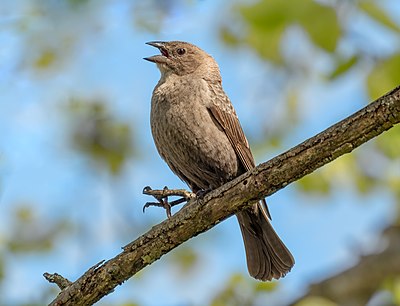Talk:Brown-headed cowbird
Cowbird's Unique Parasitism[edit]
This was a well-written article that mostly focused on the Cowbird’s parasitic behavior. It gave a full description of the specie’s reproductive behavior (parasitizing on other birds), the host response to the Cowbird’s eggs, and even the Cowbird parents’ behavior after parasitizing other birds’ nests (they would frequently come back to check on their eggs, and if their eggs have been removed by the host, the Cowbird may retaliate by destroying the host nests or eggs!). Other behavioral traits of these birds are only briefly mentioned and remain underdeveloped (for example, courting behavior). However, the article never mentions the way in which the Cowbird’s parasitism is different from other bird’s (cuckoos and honeyguides) parasitism. Instead of ejecting the eggs or killing the host’s chicks, the young Cowbirds actually perform better when there are other host young! Also, it would be good to note that experimental findings have determined that cowbird young do best when they are in a nest with two other host nestlings. Ihyuan (talk) 19:54, 25 September 2012 (UTC)
Cluster song[edit]
Instead of adding a "See also" section which remarkaly doesn't exist in this article, I'm posting this here: Lateralization of bird song has some referenced information on Molothrus ater's unusual song. ---Sluzzelin talk 14:10, 16 March 2010 (UTC) the length —Preceding unsigned comment added by 12.248.202.146 (talk) 20:02, 23 April 2010 (UTC)
Hannon[edit]
Hello 8.9.87.165. I have reverted you again. The source explains this and I previously added a WP:SECONDARY to support Hannon. Invasive Spices (talk) 23 October 2022 (UTC)
Wikipedia Ambassador Program course assignment[edit]
![]() This article is the subject of an educational assignment at Washington University supported by the Wikipedia Ambassador Program during the 2012 Fall term. Further details are available on the course page.
This article is the subject of an educational assignment at Washington University supported by the Wikipedia Ambassador Program during the 2012 Fall term. Further details are available on the course page.
The above message was substituted from {{WAP assignment}} by PrimeBOT (talk) on 16:06, 2 January 2023 (UTC)
Featured picture scheduled for POTD[edit]
Hello! This is to let editors know that File:Brown headed cowbird female in JBWR (25487).jpg, a featured picture used in this article, has been selected as the English Wikipedia's picture of the day (POTD) for February 3, 2024. A preview of the POTD is displayed below and can be edited at Template:POTD/2024-02-03. For the greater benefit of readers, any potential improvements or maintenance that could benefit the quality of this article should be done before its scheduled appearance on the Main Page. If you have any concerns, please place a message at Wikipedia talk:Picture of the day. Thank you! — Amakuru (talk) 14:27, 3 January 2024 (UTC)

|
The brown-headed cowbird (Molothrus ater) is a small cowbird in the icterid family, Icteridae. It is distinguished from other icterids by its finch-like head and beak and its smaller size. The adult male is iridescent black in color with a brown head, while the adult female is slightly smaller and is dull grey with a pale throat and very fine streaking on the underparts. The brown-headed cowbird is an obligate brood parasite, laying its eggs in the nests of other small perching birds and relying on those birds to raise its young. Its eggs have been documented in the nests of at least 220 host species, including hummingbirds and raptors. This female brown-head cowbird was photographed in Jamaica Bay Wildlife Refuge in New York City. Photograph credit: Rhododendrites
Recently featured:
|

